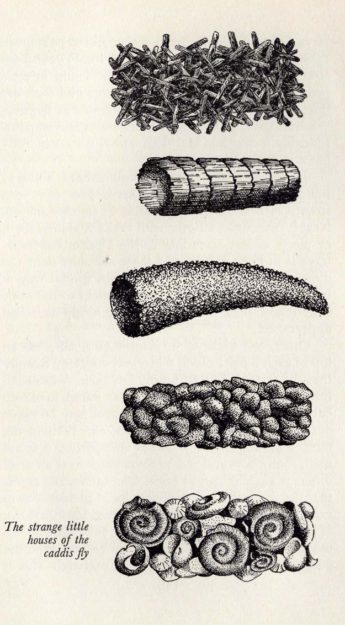Jill Norman, In Garden, Field and Pond, Londres, Hutchinson, 1958, p. 136.
It is fun to collect the strange little houses. They are to be found in most ponds and streams on the sandy bottom and there are dozens of differend kinds according to the building material used. If you see a bundle of sticks or straw suddenly sprout legs and walk away, it’s a caddis fly larva taking a walk.

Just as soon as a caddis worm hatches it starts to build a house. First of all it makes a silken tube with strands of silk emitted by glands in its tiny mouth. Next it covers this all over with sticks or stones, shells or pieces of leaf according to the kind of caddis fly larva it is. Each species, and there are more than 180 differents ones in Britain, has its own special way of building its house. Some cut small sticks to the same length and then the house has a nicely thatched appearance.
Others use sticks of varying lengths, all piled on top of each other in such a higgledy-piggledy manner that the result is like an untidy haystack. A Beautiful little caddis case can sometimes be found made up entirely of tiny snail shells, and others may be made out of grains of sand, small stones,etc. Perhaps the most beautiful is one which is shaped like a spiral shell. Many boys and girls make collections of all these different kinds of caddis cases. One interesting fact is that the caddis fly larvae always buld their houses in exactly the same way as their parents did before them. If their parents used sticks ; if they used pieces of green leaf, then the off spring will also choose the same material.